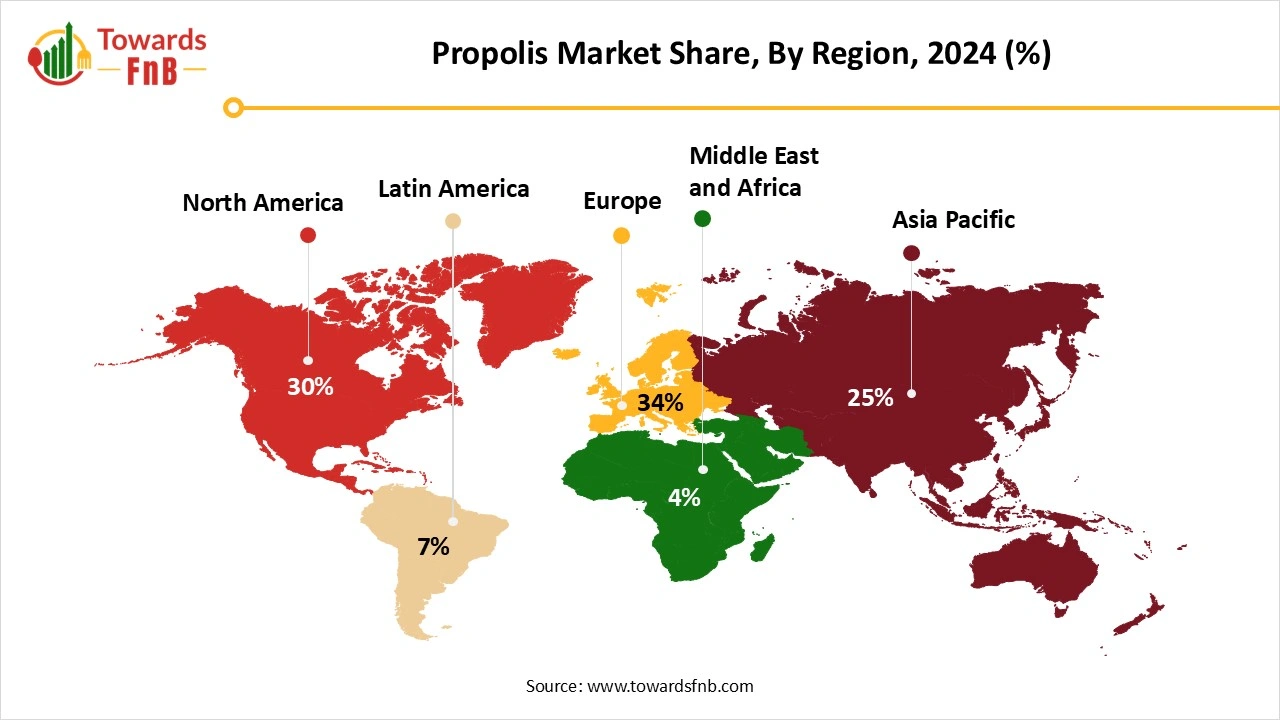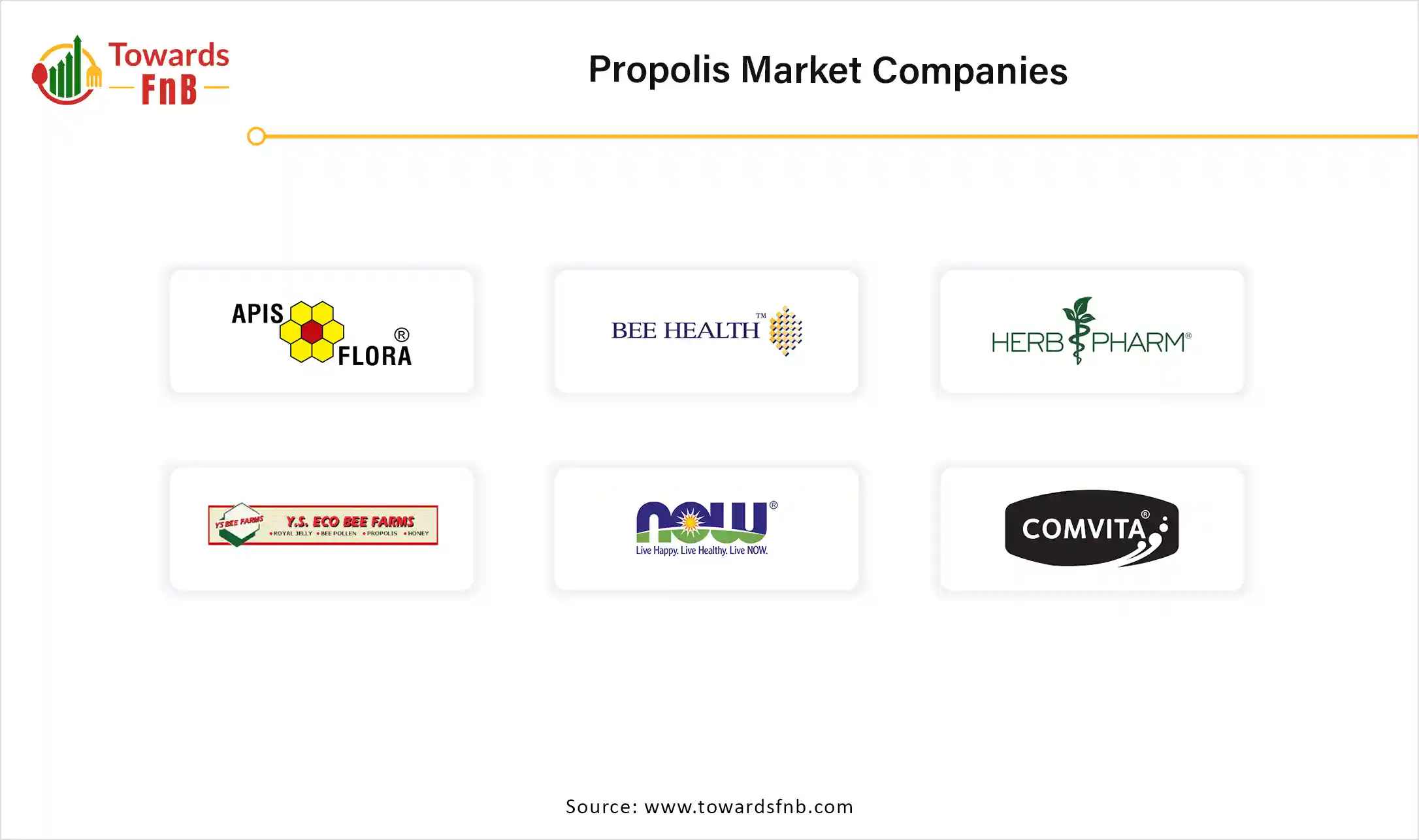November 2025
The global propolis market size reached at USD 736.95 million in 2024 and is anticipated to increase from USD 754.64 million in 2025 to an estimated USD 934.20 million by 2034, witnessing a CAGR of 2.4% during the forecast period from 2025 to 2034. The global propolis market is proliferating due to ongoing research unveiling properties and proven benefits of propolis, increasing consumer’s demand for organic and natural products along with growing awareness about preventive healthcare across the globe.

| Study Coverage | Details |
| Growth Rate from 2025 to 2034 | CAGR of 2.4% |
| Market Size in 2025 | USD 754.64 Million |
| Market Size in 2026 | USD 772.75 Million |
| Market Size by 2034 | USD 934.20 Million |
| Largest Market | Europe |
| Base Year | 2024 |
| Forecast Period | 2025 to 2034 |
| Regions Covered | North America, Europe, Asia-Pacific, Latin America, and Middle East & Africa |
Propolis is basically mixture of resin, beeswax and oils which is collected by bees to protect and build their hives to save from environmental changes. It is rich in bioactive compounds, it is widely utilized in pharmaceuticals, nutraceuticals, cosmetics, and food & beverages due to its antibacterial, antiviral, antifungal, and anti-inflammatory properties. The global propolis market includes raw propolis, processed forms (extracts, capsules, etc.), and products across multiple end-user industries.
A significant opportunity that the global Propolis market holds is increasing research and development that aims to uncover potential hidden in Propolis as a bioactive compound which is naturally derived from beehives and made by bees to cover their hives for protection from climatic changes. According to research highlighted in the European Journal of Dentistry, which shows that propolis has strong antimicrobial characteristics which can be beneficial to combating many oral diseases and can also be used as a preventive element. Further research claims to have extensive properties like antioxidants, antimicrobial and anti-inflammatory which play essential roles in various applications from pharmaceuticals, skincare products, and functional food additives. Thus, propolis is well-known due to its evidence-based properties, supporting the market’s growth globally and creating further lucrative opportunities.
Despite having numerous benefits, the propolis market still faces some barriers that need to be resolved in order to expand market growth further. A significant hurdle is increasing competition from synthetic alternatives which can offer the same health benefits with lesser side effects at a lower cost. As natural propolis is price-sensitive and more expensive than other synthetic products that can replace propolis as a main ingredient, synthetic alternatives give price friendly products offering similar health benefits. However, to mitigate this challenge, more research should be done to understand the deeper composition and benefits of propolis over synthetic ones by neglecting its price.
How is Europe Supporting Global Propolis Market Growth?
Europe dominated the global propolis market in 2024. The region is dominating due to various factors including strong regulatory frameworks, growing consumers demand for natural products, range of industrial applications and traditional usage of propolis. Europe boasts a well-developed regulatory framework for natural health products to avoid misuse of such products and ensure safety, quality and efficacy. Many industries are opting for propolis as a safe content including food and beverages, skin/personal care products, medicinal products and others due to such a well-regulated framework and to strengthen their position in the global market.
Additionally, European consumers are seeking products that are natural, organic and aligned with their personal health goals. Propolis is perceived as a safe natural ingredient, and it was originally used in European tradition for centuries as it is derived from beehives. Propolis shows properties like anti-inflammatory, Antioxidant and Anti-inflammatory along with other health-supporting properties.

Why is Asia Pacific Growing at a Higher Rate in the Market?
Asia Pacific is expected to grow at the fastest CAGR during the foreseeable period. The region is experiencing robust growth rates for various reasons, like conventional medicinal practices, growing income per capita, and rising awareness about health issues. Developing countries like Japan, India, China and South Korea are leading contributors to the global propolis market. These countries have been utilizing propolis for a long time, especially for medicinal practices, strengthening its popularity in the regions.
Disposable income in Asia Pacific has seen significant growth over the past years. It indirectly influences people's choices and lifestyle. People are becoming more conscious and have developed a practical approach to overall health, including mental and physical well-being, supporting the usage of propolis and increasing its demand in the market. Propolis offers antioxidant and anti-inflammatory properties that are crucial for any nutraceutical health product to boost immunity, further driving the demand for propolis as a main ingredient.
Why does Propolis Extracts Product hold the largest Share in the Global Propolis Market?
The propolis extract segment dominated the global market in 2024. The segment is dominating due to its versatile applications in sectors like cosmetics, pharmaceuticals, food and beverages, and dietary supplements. Propolis extracts are used for some dermatology medications to treat skin conditions like neurodermatitis, acne, and wound healing. Propolis is also in cosmetics for its potential skin-healing nature and anti-ageing effects. In the food and beverage sector, propolis can be utilized as a natural flavor enhancer and preservative.it is also popular for its immunity-boosting properties. Furthermore, ongoing innovations in formulations of propolis products and delivery methods like capsule or tablet form are further driving the segment’s growth.
The Propolis Capsules/Tablets Segment is Expected to Grow at the Fastest CAGR During the Upcoming Period.
The segment is expanding as it is the simplest form of propolis product that can be easily utilized and widely used by many consumers. Dietary supplements are also incorporated with propolis in the form of capsules and tablets to improve digestion, which further supports market growth.
How does Pharmaceutical as an Application Influences the Global Propolis Market?
Pharmaceutical segment dominated the global propolis market in 2024. The segment is dominating due to its proven health benefits when used in the form of capsules and tablets, increasing consumer trust for propolis as a safe ingredient and growing shift towards natural remedies for various health issues. Propolis is popular for its immune-boosting and antioxidant properties which help combat oxidative stress in the human body. Precise dosage of propolis can be beneficial for consistent delivery of Propolis in the form of tablets and capsules. These are the most familiar forms of pharmaceutical products.
The Nutraceuticals/Dietary Supplements Segment is Expected to Grow at the Fastest CAGR in the Foreseeable Period.
The segment is experiencing a significant growth rate because of growing preferences for organic products to heal any kind of diseases and proactive approach to stay healthy. As propolis is a substance produced by bees and has potential therapeutics properties such as antioxidant, anti-inflammatory along with anti-microbial. Since nutraceuticals are bioactive compounds that are naturally derived from main sources and gaining attention in the market to treat various diseases.
Why is Liquid Form of Propolis the Most Used Across the Globe Propolis Market?
Liquid form segment dominated the global propolis market in 2024. The segment is dominating due to liquid form propolis is easy to digest and mix with versatile applications. Its popularity is increasing as it offers many health benefits such as relief from digestive and cold syndromes. Liquid propolis is suitable for its applications in nutraceuticals, food and beverages, and cosmetics products. Liquid propolis offers various formulations easily without any lumps and thus, can be used as a natural preservative also.
The Capsule/Tablets Segment is Expected to Grow at the Fastest CAGR in the Upcoming Period.
The segments growth can be attributed to the convenience offered by tablet and capsule form of propolis. A precise dosage can be registered in the body with capsule and tablets form which reduces potential side effects of overdosing propolis. It provides a practical and effective way to deliver recommended dosage of propolis, fueling the market's growth globally.
Why are Pharmacies/Drugstores Dominated the Global Propolis Market?
Pharmacies/drugstore segment dominated the global propolis market in 2024. The segment’s growth is attributed to the vast network of pharmacies and drugstores making access to propolis easy and convenient. Consumers found the retail products more reliable as they can physically supervise it. Moreover, staff and pharmacists can shed light on valuable information about the benefits of propolis and how to use it as per direction. Also, pharmacies and drugstores have different products with various brands and price ranges with different forms like tablets, capsules, liquid and creams etc.
The Online Retail Segment is Expected to Grow at the Fastest CAGR in the Upcoming Period.
The segment is expanding due to a variety of product selection, doorstep delivery and consumer's preference to leverage benefits offered by e-commerce platforms. Digital platforms also allow direct-to-consumer sales, further contributing to the segment's growth. Digital platforms also enable targeted advertisements for specific groups of consumers and provide personalized recommendations which drive market growth further.
How is the Poplar Type Source Helping the Propolis Market Grow Significantly?
The poplar type segment dominated the propolis market in 2024. The segment’s growth can be attributed to factors like the easy availability of sources of resin in various temperate regions that allow it to be easily gathered by bees. Poplar propolis is popular for its dense level of flavonoids like galangin and chrysin along with caffeic acid esters, which provide numerous health benefits. Also, poplar propolis is already studied well and has undergone various experiments to decide its effectiveness. Thus, it's a widely known source of propolis fueling the segments' growth on a large scale.
The Green Propolis Segment is Expected to Grow at the Fastest CAGR During the Forecasted Years.
The segment is expanding significantly in the global propolis market as it provides unique composition, characteristics and number of health benefits along with consumers inclination towards natural-based products. Green propolis contains specific bioactive elements like antipilling C with higher concentration. Green propels due to its properties like anti-inflammatory, antimicrobial, and antioxidants. It is majorly used in sectors like functional food, cosmetics, and dietary supplements.
ApiotiX Technologies
ApiotiX technology
NextGen Actives

By Product Type
By Application
By Form
By Distribution Channel
By Source
By Region
The global citrus pectin market size is projected to grow from USD 574.81 billion in 2025 to around USD 680.91 billion by 2034, reflecting a CAGR of 1...
The global resistant maltodextrin market size is expected to grow from USD 488.44 million in 2025 to USD 963.45 million by 2034, at a CAGR of 7.84% ov...
November 2025
November 2025
November 2025
November 2025